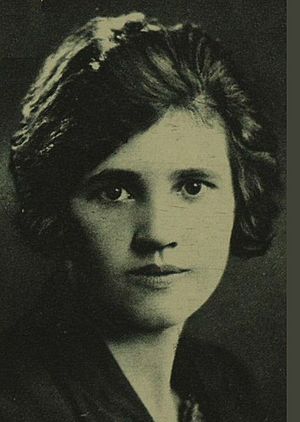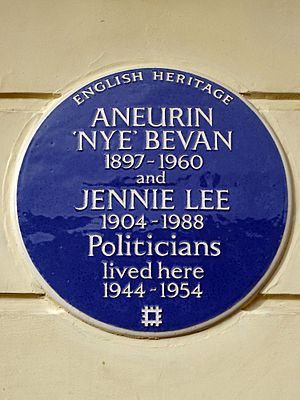Jennie Lee, Baroness Lee of Asheridge facts for kids
Quick facts for kids
The Baroness Lee of Asheridge
|
|
|---|---|

Lee in 1929
|
|
| Minister for the Arts | |
| In office 20 October 1964 – 19 June 1970 |
|
| Prime Minister | Harold Wilson |
| Preceded by | Office created |
| Succeeded by | David Eccles |
| Member of Parliament for Cannock |
|
| In office 5 July 1945 – 29 May 1970 |
|
| Preceded by | William Murdoch Adamson |
| Succeeded by | Patrick Cormack |
| Member of Parliament for North Lanarkshire |
|
| In office 22 March 1929 – 7 October 1931 |
|
| Preceded by | Alexander Sprot |
| Succeeded by | William Anstruther-Gray |
| Personal details | |
| Born |
Janet Lee
3 November 1904 Lochgelly, Fife, Scotland |
| Died | 16 November 1988 (aged 84) |
| Citizenship | United Kingdom |
| Political party | Labour |
| Spouse | |
| Alma mater | University of Edinburgh |
| Occupation | Politician |
| Known for | Playing a leading role in the foundation of the Open University |
Janet Lee, Baroness Lee of Asheridge, known as Jennie Lee, was an important Scottish politician. She was a member of the Labour Party. She served as a MP (a person elected to represent a group of voters in parliament) from 1929 to 1931. Later, she was an MP again from 1945 to 1970.
As the first Minister for the Arts in Harold Wilson's government (1964–1970), she helped create the Open University. This university allowed anyone to study, no matter their past education. She worked closely with Harold Wilson to make sure everyone had a chance to learn.
Jennie Lee was married to Aneurin Bevan, another Labour politician, from 1934 until he passed away in 1960.
Contents
Early Life of Jennie Lee
Jennie Lee was born on November 3, 1904, in Lochgelly, Scotland. Her parents were Euphemia Grieg and James Lee. Her father was a miner and later ran a hotel. She had a younger brother named Tommy.
Jennie followed her father's political beliefs. Like him, she joined the Scottish Independent Labour Party (ILP). Her grandfather, Michael Lee, was also involved in politics. He was a friend of Keir Hardie, a founder of the Labour Party. Jennie later joined the main Labour Party.
Jennie Lee's Education
Jennie Lee went to Beath High School. She was the top student in her final year. The Carnegie Trust and local councils helped pay for her university studies. She attended the University of Edinburgh to become a teacher. Later, she won a scholarship to study law.
At university, she was very active. She joined the Labour Club and the student newspaper. One of her first campaigns was to elect the famous philosopher Bertrand Russell as the university's leader. She graduated in 1927 with degrees in Arts and Law, plus a teaching certificate. After university, she worked as a teacher in Cowdenbeath.
First Time as an MP
Jennie Lee became a candidate for the ILP in North Lanarkshire. She won a special election in 1929. This made her the youngest woman to become a Member of Parliament. At that time, women under 30 could not even vote! She was re-elected in the general election that same year.
In parliament, she quickly disagreed with the Labour Party leaders. She was known for her strong left-wing views. Her first speech was a powerful attack on the budget plans of Winston Churchill. Even Churchill was impressed by her speech. She lost her seat in the 1931 election. This happened when Ramsay MacDonald formed a new government that Jennie did not support.
Out of Parliament
Even when she was not an MP, Jennie Lee stayed active in politics. She worked to get British support for the government in the Spanish Civil War. This government was fighting against Francisco Franco's forces. She also wrote as a journalist for the New Leader newspaper.
She even traveled to Spain in 1937 to report on the war. She met George Orwell there. She also attended a parade for British volunteers fighting in Spain.
She tried to get re-elected in 1935 and 1943 but was not successful. During this time, she also worked as a journalist for the Daily Mirror.
Return to Parliament
Jennie Lee rejoined the Labour Party. In the 1945 general election, she was elected again. This time, she represented the Cannock area in England. She remained a strong left-winger. She sometimes disagreed with her husband, Aneurin Bevan, on political issues. For example, she did not support the UK having nuclear weapons, while he did.
In 1964, she was made the first ever Minister for the Arts by Prime Minister Harold Wilson. In this role, she played a huge part in creating the Open University. Harold Wilson later said this was the greatest achievement of his time as Prime Minister.
Creating the Open University
The idea for the Open University was like a "University of the Air." It aimed to help people who had not had the chance to go to university. Jennie Lee wrote a plan in 1966 for how the university would work. It would teach students through mail and TV broadcasts.
Prime Minister Harold Wilson strongly supported the idea. He saw it as a way for the Labour Party to modernize Britain. He believed it would help the economy and create more equal opportunities. Using TV and radio also connected the university to new technology.
However, many people were doubtful or even against the idea. This included government officials and other politicians. But Jennie Lee was very determined. With strong support from Wilson, the university was finally created. It received its official approval on April 23, 1969. Students started applying in 1970 and began studying in 1971.
In 1973, Jennie Lee spoke at the laying of the foundation stone for the first Open University library. She said the university was "a great independent university which does not insult any man or any women whatever their background by offering them the second best, nothing but the best is good enough."
Expanding the Arts Council
Jennie Lee also helped the Arts Council of Great Britain. In 1967, she renewed its official document, which allowed it to do more work. This led to more arts activities in different regions of the UK. New arts centers were also created in London, like those at the South Bank Centre.
She also wrote an important government paper about the Arts. This was the only one of its kind for the next 50 years. After 1967, she was promoted to a higher role in the Department of Education and Science. Before that, she had worked in the Ministry of Public Building and Works.
Retirement and Later Life
In the 1970 election, Jennie Lee lost her seat in Cannock. She then retired from being an MP. On November 5, 1970, she was given the title Baroness Lee of Asheridge. This meant she became a member of the House of Lords.
She wrote four books during her life. These included "New Day" (1939) and "My Life with Nye" (1980), which was about her husband.
In 1974, she received an honorary law degree from the University of Cambridge. In 1981, she became an honorary member of the Royal Academy of Arts.
Jennie Lee passed away in 1988 at the age of 84. She left her personal papers to the Open University. They are now kept there as the Jennie Lee Collection.
Memorials
Many places and things are named after Jennie Lee to remember her contributions:
- A community center in Wednesfield was named the "Jennie Lee Centre."
- Students at Adam Smith College in Scotland chose to name their association the "Jennie Lee Students' Association." They felt she was a great role model.
- The Jennie Lee building is at the Open University Campus in Milton Keynes.
- Another Jennie Lee building houses the Open University offices in Scotland.
- In Rugeley, Staffordshire, there is a street called Jennie Lee Way.
- A plaque near the University of Edinburgh honors her as an early woman MP and founder of the Open University.
- An English Heritage plaque in London celebrates both Nye Bevan and Jennie Lee.
- The community library in her hometown of Lochgelly was renamed the Jennie Lee Library.
- A street in Overtown, Scotland, is named Jennie Lee Drive.
- The Albany Learning and Conference Centre in Glasgow has a Jennie Lee room.
- There is even a play about her life called "Jennie Lee: Tomorrow Is A New Day."




